Swiss Cheese Plant Vs Monstera: What’s the Difference?
When comparing Monstera deliciosa and Monstera adansonii, both referred to as the Swiss Cheese Plant, look at their leaf morphology. Monstera deliciosa boasts large, glossy leaves with deep fenestrations, while Monstera adansonii has smaller, delicate leaves with oval perforations.
You’ll notice deliciosa grows more robustly and upright, while adansonii tends to vine and requires support. Both belong to the Araceae family, thriving in filtered sunlight with similar soil and watering needs.
Detailing these distinguishing characteristics will aid in proper identification and care, thereby enhancing your botanical expertise. Continue to explore for more nuanced cultivation and care tips to ensure plant health.
Differences Between Swiss Cheese Plant and Monstera
| Feature | Swiss Cheese Plant (Monstera Adansonii) | Monstera (Monstera Deliciosa) |
|---|---|---|
| Common Names | Swiss Cheese Vine, Five Holes Plant | Swiss Cheese Plant, Split-leaf Philodendron |
| Leaf Structure | Smaller, heart-shaped leaves with oval holes (fenestrations) | Larger, split leaves with deep lobes and holes |
| Leaf Size | Typically 6-12 inches long | Can grow up to 3 feet long and wide |
| Growth Habit | Vining plant, often grown as a hanging or climbing plant | Climbing plant, can grow large and bushy |
| Stems | Thinner, more delicate stems | Thicker, more robust stems |
| Growth Rate | Fast-growing | Moderate to fast-growing |
| Habitat | Native to tropical rainforests of Central and South America | Native to tropical rainforests of Central America |
| Care Requirements | Moderate light, high humidity, and regular watering | Bright, indirect light, high humidity, and regular watering |
| Mature Size | Smaller overall size, suitable for smaller spaces | Larger plant, needs more space to grow |
| Propagation | Easy to propagate via stem cuttings | Easy to propagate via stem cuttings or air layering |
| Flowers and Fruit | Rarely flowers indoors, non-edible fruit | Flowers infrequently indoors, produces edible fruit |
| Popularity | Popular as a houseplant due to its manageable size | Very popular as a houseplant, known for its dramatic foliage |
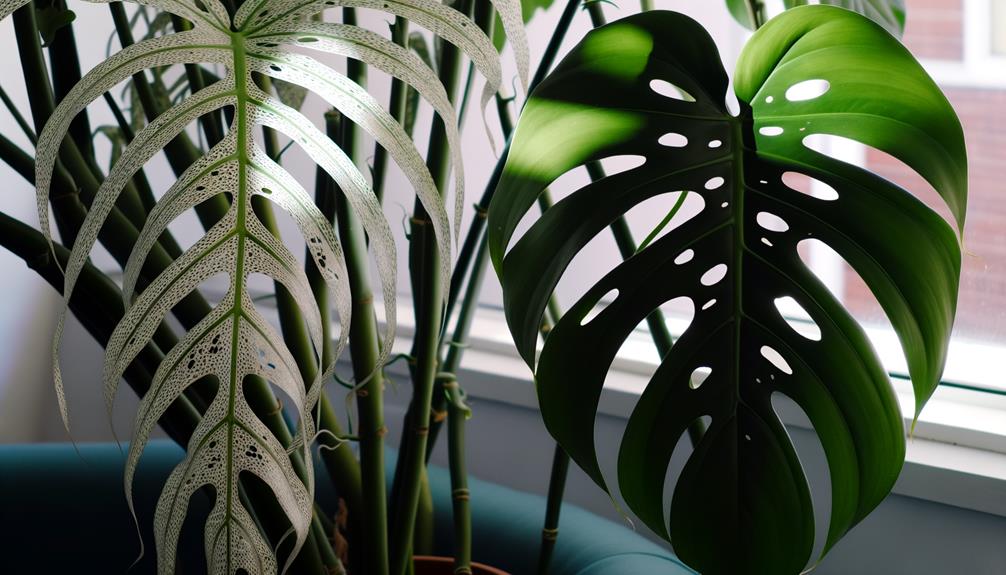
Key Takeaways
- Monstera deliciosa has large, glossy leaves with deep fenestrations, while Monstera adansonii has smaller leaves with oval perforations.
- Monstera deliciosa grows upright and robustly, whereas Monstera adansonii is more vining and compact.
- Both plants require filtered sunlight and partial shading to mimic their natural tropical rainforest habitat.
- Monstera deliciosa needs less frequent watering compared to the more delicate and thirsty Monstera adansonii.
- Monstera deliciosa is commonly known as the ‘Swiss Cheese Plant,’ while Monstera adansonii is often referred to as the ‘Swiss Cheese Vine.’
Origin and History
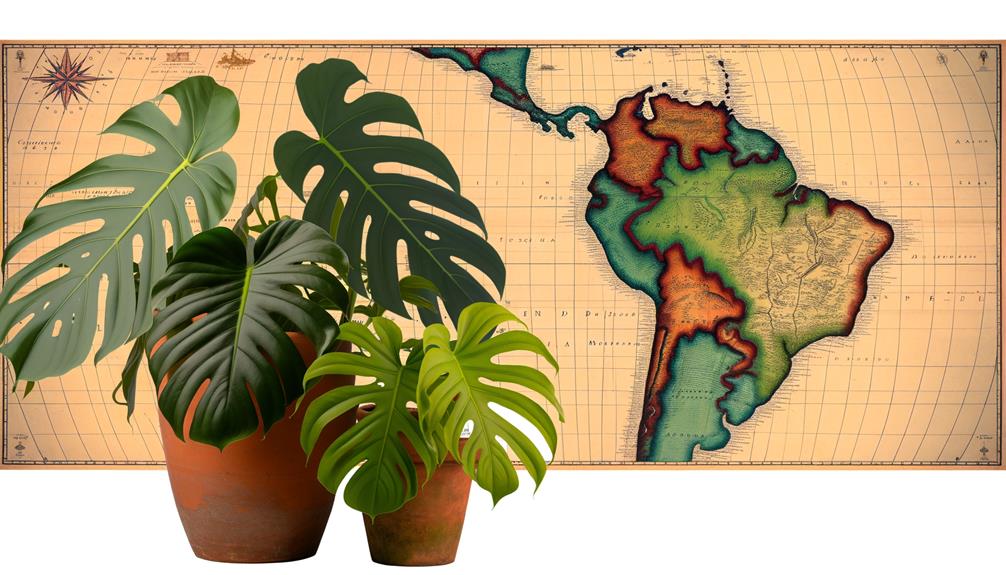
Originally native to the tropical rainforests of Central and South America, Monstera deliciosa, commonly known as the Swiss Cheese Plant, has a rich history of cultivation dating back to the 19th century.
You’ll find that this plant thrives in the understory of dense forests, where it climbs trees using its aerial roots. The species name ‘deliciosa’ refers to the edible fruit it produces, which has a unique flavor profile combining pineapple and banana notes.
Botanists first documented Monstera deliciosa in 1840, and it quickly became a favorite among horticulturists for its striking fenestrated leaves and robust growth habits. In controlled environments, it can reach heights of 20 meters, making it a dramatic addition to any collection.
Common Misconceptions
One common misconception is that Monstera deliciosa and Monstera adansonii are the same plant, when in fact they differ significantly in leaf morphology and growth habits.
Monstera deliciosa, often called the Swiss Cheese Plant, features large, glossy leaves with deep, irregular fenestrations. In contrast, Monstera adansonii, known as the Swiss Cheese Vine, has smaller, more delicate leaves with numerous oval holes.
You’ll notice that M. deliciosa grows more vigorously, typically reaching greater heights and developing thicker stems. M. adansonii, however, tends to be more vining, often requiring support structures for best growth.
It’s essential to recognize these differences to provide appropriate care and environment, ensuring each species thrives in your indoor garden.
Botanical Classification

When discussing the botanical classification of the Swiss Cheese Plant and Monstera, you’ll notice they’re both from the Araceae family but differ in their scientific names.
Monstera deliciosa, commonly known as the Swiss Cheese Plant, and Monstera adansonii exhibit distinct growth habits and morphological characteristics.
You’ll find these differences essential for proper identification and understanding of their unique origins within the broader plant family.
Scientific Naming Differences
The Swiss Cheese Plant, scientifically known as Monstera deliciosa, and the Monstera genus itself are often confused, but they represent distinct classifications within the Araceae family.
Monstera deliciosa specifically refers to the well-known plant with fenestrated leaves, whereas the Monstera genus encompasses a broader range of species, such as Monstera adansonii and Monstera obliqua. Each species within the genus possesses unique morphological characteristics.
For instance, Monstera adansonii, often called the ‘Adanson’s Monstera,’ exhibits smaller, more numerous holes in its leaves compared to Monstera deliciosa.
You should note that the genus Monstera is part of the Araceae family, which also includes other genera like Philodendron and Anthurium. This classification aids in understanding their evolutionary relationships and ecological niches.
Plant Family Origins
In the field of botanical classification, Monstera deliciosa and its relatives within the Araceae family originate from tropical regions of Central and South America, where they thrive in humid, rainforest environments. You’ll find these plants, including Philodendron and Anthurium, exhibiting remarkable adaptations to their habitats.
Monstera deliciosa, known for its fenestrated leaves, belongs to the Monsteroideae subfamily. This plant’s aerial roots and epiphytic nature enable it to climb trees and access light in dense forest canopies.
The Araceae family, characterized by its spadix and spathe inflorescence, includes over 3,000 species. Understanding these origins highlights the evolutionary strategies these plants use to maximize growth and survival in their native ecosystems.
Growth Habit Variations
Many species within the Monstera and Araceae families exhibit diverse growth habits, ranging from terrestrial to epiphytic lifestyles, showcasing their adaptability to various microhabitats.
Monstera deliciosa, commonly known as the Swiss Cheese Plant, often starts as a terrestrial plant, eventually becoming epiphytic as it climbs trees. This growth habit allows it to reach sunlight in dense forests.
On the other hand, Monstera adansonii, while also capable of epiphytic growth, often remains closer to the ground, utilizing its aerial roots to anchor itself.
Species like Philodendron hederaceum from the Araceae family demonstrate similar versatility, thriving both terrestrially and as epiphytes. Understanding these growth variations helps you appreciate their ecological roles and informs proper cultivation techniques.
Varieties of Monstera
You’ll find a fascinating array of Monstera varieties, each with unique characteristics and scientific classifications, like Monstera deliciosa, Monstera adansonii, and Monstera obliqua.
Monstera deliciosa, commonly known as the Swiss Cheese Plant, boasts large, glossy leaves with deep fenestrations.
Monstera adansonii, or the Swiss Cheese Vine, is characterized by smaller leaves with numerous oval to round perforations.
Monstera obliqua is a rare variety, distinguished by its extremely delicate, paper-thin leaves with extensive perforations and fenestrations.
Each species varies in leaf morphology, growth pattern, and environmental requirements. Understanding these distinctions helps you cultivate and care for these tropical plants effectively, ensuring they thrive in your home or garden.
Identifying Features
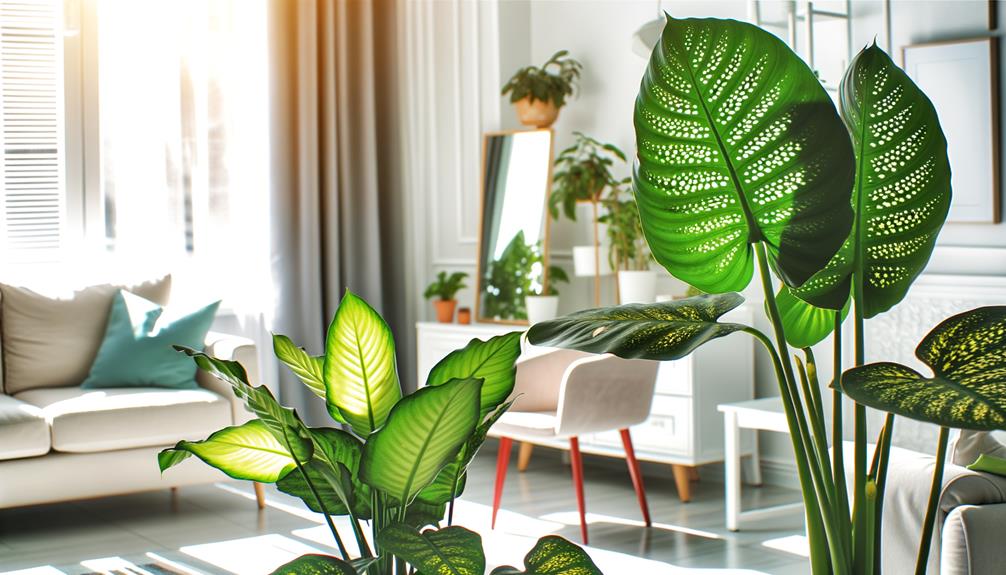
To distinguish Swiss Cheese Plant (Monstera adansonii) from Monstera deliciosa, you’ll focus on leaf shape differences and growth patterns.
Monstera adansonii features smaller, more perforated leaves, while Monstera deliciosa exhibits larger, split leaves with deep fenestrations.
Both species demonstrate unique climbing habits, but Monstera deliciosa tends to grow more robustly.
Leaf Shape Differences
When comparing the leaf shapes of the Swiss Cheese Plant (Monstera adansonii) and Monstera deliciosa, you’ll notice distinct differences in fenestration and overall morphology.
Monstera adansonii exhibits smaller, thinner leaves with numerous perforations that often extend to the edges, creating a lace-like appearance. These fenestrations are irregularly shaped and distributed across the leaf surface.
In contrast, Monstera deliciosa presents larger, sturdier leaves with deep, symmetrical splits and smaller, oval-shaped holes that don’t typically reach the edges. The splits in Monstera deliciosa leaves contribute to their iconic, palm-like form, while Monstera adansonii’s perforations give it a more delicate aesthetic.
Recognizing these differences is essential for accurate identification and best care of each species.
Growth Patterns
In examining the growth patterns of Monstera deliciosa and Monstera adansonii, you’ll observe distinct variations in leaf fenestration and climbing behavior. Monstera deliciosa, or the Swiss Cheese Plant, exhibits larger leaves with prominent fenestrations as it matures. These fenestrations aid in reducing wind resistance and maximizing light capture.
On the other hand, Monstera adansonii, often referred to as the Swiss Cheese Vine, produces smaller, more perforated leaves, better suited for its natural vining habit. Both species employ adventitious roots for climbing, but M. adansonii typically exhibits a more vigorous climbing tendency.
| Feature | Monstera deliciosa | Monstera adansonii |
|---|---|---|
| Leaf Size | Large | Smaller |
| Leaf Fenestration | Deep, prominent | Multiple, smaller holes |
| Climbing Mechanism | Adventitious roots | Adventitious roots |
| Vining Habit | Moderate | Vigorous |
| Natural Habitat | Tropical rainforests | Tropical rainforests |
Light Requirements
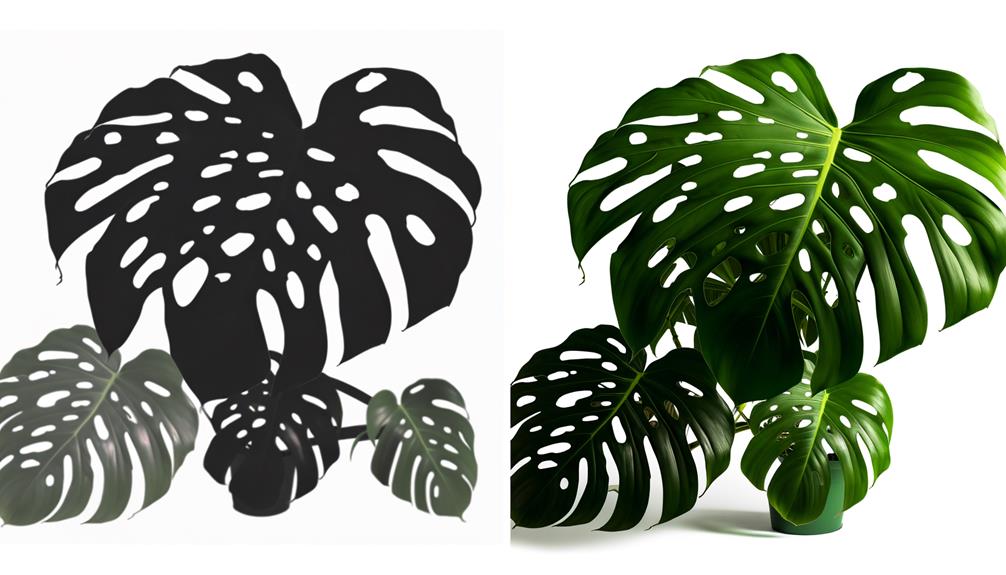
When caring for Monstera deliciosa, make sure it receives bright indirect light to mimic its natural understory habitat. It can tolerate low light conditions, but inadequate light will slow its growth rate.
Regularly rotate the plant to make sure even light distribution and prevent phototropism, where the plant bends towards the light source.
Bright Indirect Light
Both the Swiss cheese plant (Monstera deliciosa) and its relatives thrive under bright indirect light, which mimics the dappled sunlight of their natural rainforest habitat. This type of lighting promotes photosynthesis without the risk of leaf burn.
For your Monstera, position it near an east or west-facing window, filtered by sheer curtains.
Key characteristics of ideal bright indirect light include:
- Filtered sunlight: Prevents direct exposure while allowing enough light for photosynthesis.
- Consistent light levels: Avoids drastic changes that can stress the plant.
- Partial shading: Mimics the forest canopy effect.
- High light intensity: Supports vigorous growth and large leaf development.
- Avoidance of direct beams: Protects the delicate leaves from scorching.
Ensure your plant thrives in this environment for lush, fenestrated leaves.
Low Light Tolerance
Contrary to their preference for bright indirect light, the Swiss cheese plant (Monstera deliciosa) and its relatives demonstrate a surprising degree of low light tolerance, making them versatile houseplants.
In conditions of reduced light, these plants can adapt by slowing their growth rate and producing larger, thinner leaves to maximize photosynthetic efficiency.
You’ll notice that Monstera adansonii, a close relative, exhibits similar adaptability. However, prolonged low light can lead to leggy growth and smaller fenestrations in leaves.
It’s essential to monitor signs of light deficiency, such as yellowing or dropping leaves. While they won’t thrive in dark corners, Monstera species can tolerate dimmer environments better than many other houseplants, maintaining their aesthetic appeal in a variety of indoor settings.
Light Rotation Needs
To maximize growth and health, Monstera deliciosa and Monstera adansonii benefit from a strategic light rotation regimen, balancing their low light tolerance with periods of bright, indirect light. By doing so, you can prevent leggy growth and promote robust foliage.
Implement the following light rotation strategy:
- Place your Monstera near an east-facing window to receive morning sunlight.
- Rotate the plant every week to maintain even light distribution.
- Use sheer curtains to filter intense afternoon sunlight.
- Supplement with grow lights if natural light is inadequate, especially during winter.
- Monitor for signs of light stress, like yellowing leaves or sunburn.
This approach leverages natural light cycles, promoting photosynthesis while minimizing stress, ensuring your Monstera thrives year-round.
Watering Needs
When it comes to watering needs, Monstera deliciosa and Monstera adansonii require a balance of moisture and aeration to thrive. Water them when the top inch of the soil feels dry to the touch. Overwatering can lead to root rot, a common issue in these species.
Guarantee your pot has drainage holes to prevent water from stagnating. Use tepid water to avoid shocking the roots.
During winter, reduce watering frequency as the plants enter a period of dormancy. Always check the soil moisture level with your finger or a moisture meter to prevent over- or under-watering. By maintaining consistent, moderate hydration, you’ll help your Monstera plants develop robust root systems and lush, healthy foliage.
Soil and Fertilizer

For best growth, Monstera deliciosa and Monstera adansonii require a well-draining soil mix enriched with organic matter.
You should use a blend that includes:
- Peat moss for moisture retention
- Perlite or pumice for aeration
- Compost to supply essential nutrients
- Pine bark to improve drainage
- Activated charcoal to filter impurities
Ensure the soil mix maintains a pH between 5.5 and 7.0.
Fertilize your Monsteras bi-monthly during the growing season with a balanced, water-soluble fertilizer (20-20-20 NPK). Dilute the fertilizer to half-strength to avoid root burn.
In winter, reduce fertilization as growth slows. This regimen promotes robust growth and vibrant foliage, catering to the plant’s specific nutrient needs.
Pruning and Maintenance
Regular pruning is essential for maintaining the health and appearance of your Monstera deliciosa and Monstera adansonii, ensuring they don’t become overgrown or leggy. Begin by sterilizing your pruning shears to prevent the spread of pathogens.
Focus on removing yellowing or damaged leaves, cutting just above a node to encourage new growth. For Monstera deliciosa, trim aerial roots if they become unruly, but don’t remove them entirely as they assist in nutrient absorption. For Monstera adansonii, pruning can help manage its vining habit.
Always make clean cuts to minimize stress on the plant. Regular maintenance includes dusting leaves to maximize photosynthesis and inspecting for signs of disease.
Proper pruning promotes vigorous growth and enhances overall plant aesthetics.
Common Pests
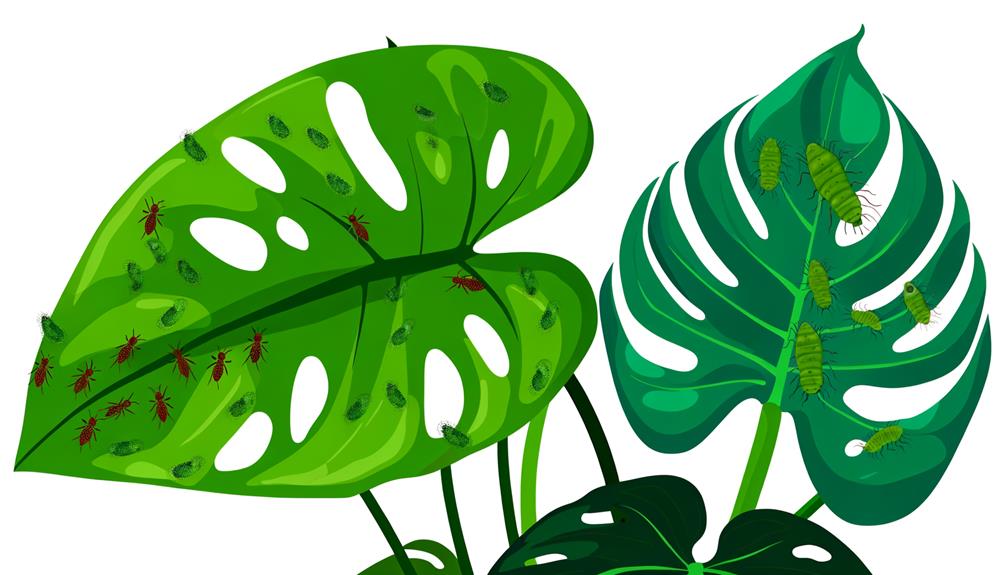
Both Monstera deliciosa and Monstera adansonii are susceptible to several common pests, including spider mites (Tetranychidae), mealybugs (Pseudococcidae), and scale insects (Coccoidea).
To protect your plants, closely monitor them for these pests:
- Spider mites (Tetranychidae): Tiny arachnids that cause stippling and yellowing of leaves.
- Mealybugs (Pseudococcidae): Cotton-like masses on stems and leaf nodes, secreting honeydew.
- Scale insects (Coccoidea): Hard or soft bodies that attach to stems, sucking plant sap.
- Thrips (Thysanoptera): Small, elongated insects causing silver streaks and leaf distortion.
- Aphids (Aphidoidea): Small, sap-sucking insects found in clusters, often leading to sooty mold.
Regularly inspect your plants and take prompt action to manage infestations.
Benefits for Indoor Air Quality
While managing pests is essential for plant health, understanding how Monstera deliciosa and Monstera adansonii can enhance indoor air quality reveals additional benefits of cultivating these plants.
Both species excel at filtering airborne toxins such as formaldehyde, benzene, and trichloroethylene. The broad, fenestrated leaves of Monstera deliciosa maximize the surface area for gas exchange, improving their efficiency in absorbing pollutants. Monstera adansonii, with its perforated foliage, also contributes to air purification through similar mechanisms.
These plants increase ambient humidity by releasing water vapor during transpiration, which can alleviate respiratory issues and improve overall air quality. By integrating these Monsteras into your living space, you’ll not only enjoy aesthetic appeal but also foster a healthier indoor environment.
How To Care For Monstera Swiss Cheese Plant
To care for a Monstera Swiss Cheese Plant:
- Light: Bright, indirect light.
- Water: Water when the top inch of soil is dry; ensure good drainage.
- Humidity: High humidity; use a humidifier or mist leaves.
- Temperature: 65-85°F (18-29°C).
- Soil: Well-draining potting mix.
- Fertilizer: Feed monthly with a balanced liquid fertilizer in spring and summer.
- Pruning: Trim yellow or dead leaves; prune for size and shape.
- Support: Use a moss pole or trellis for support.
- Pests: Check for pests like spider mites and treat as needed.
These guidelines will help keep your Monstera Swiss Cheese Plant healthy and thriving.
Conclusion
To sum it up, grasping the Swiss cheese plant (Monstera deliciosa) and its different Monstera relatives comes down to identifying their distinctive characteristics, care requirements, and advantages.
By becoming proficient in the basics such as botanical categorizations, soil and fertilizer choices, and pest control, you’ll ensure your Monstera flourishes.
Keep in mind, a well-cared-for Monstera not only improves your environment but also cleanses the air, creating a beneficial situation for your indoor garden and well-being.






